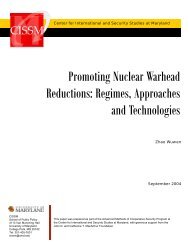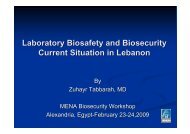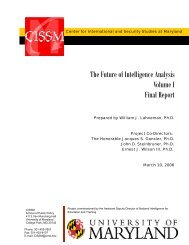A Reassurance-Based Approach to Space Security - Center for ...
A Reassurance-Based Approach to Space Security - Center for ...
A Reassurance-Based Approach to Space Security - Center for ...
- No tags were found...
Create successful ePaper yourself
Turn your PDF publications into a flip-book with our unique Google optimized e-Paper software.
Because the United States, Russia, and China have the most advanced military spaceprograms, have each conducted ASAT tests, and are the most focused on the strategic sideof space security, they need <strong>to</strong> be constructively engaged from the outset. But if the initialphase of negotiations involved only these three countries, the deliberations would arguablybe <strong>to</strong>o heavily focused on the military side of space security and <strong>to</strong>o likely <strong>to</strong> devolve in<strong>to</strong>traditional arms control arguments. Using technical criteria <strong>to</strong> decide which other states <strong>to</strong>include in initial deliberations, such as a state’s ability <strong>to</strong> launch objects in<strong>to</strong> space, would notnecessarily be a good option either. Doing so would allow some countries whoseparticipation was not essential <strong>to</strong> play a spoiler role, while excluding other countries, such asCanada, which has an active space program and a long-standing interest in cooperative spacesecurity. The best option might be <strong>to</strong> invite all countries who have demonstrated asignificant interest in space security <strong>to</strong> participate in the discussions and eventualnegotiations, but <strong>to</strong> set participation costs sufficiently high so that only those countries thathave a major stake in the outcome would likely choose <strong>to</strong> be active participants.The Antarctic Treaty offers one model of a flexible, non-discrimina<strong>to</strong>ry way <strong>to</strong>authorize decision-making powers depending on a state’s demonstrated level of interest andcommitment. 41 At the invitation of the United States, the main treaty was negotiated in lessthan three months by the twelve countries participating in the International GeophysicalYear of 1957-58. This group included all seven countries that had claimed sovereignty overareas of Antarctica and most of the other countries that had engaged in scientific explorationthere. The treaty created two categories of members, which have come <strong>to</strong> be known asConsultative and Non-Consultative. All original signa<strong>to</strong>ries are Consultative members, as isany country that acceded <strong>to</strong> the treaty and demonstrated their interest in Antarctica by“conducting substantial research activity there.”Representatives of the Consultative members meet at semi-regular intervals <strong>to</strong>exchange in<strong>for</strong>mation, discuss treaty-related matters, and develop recommendationsregarding additional measures <strong>to</strong> further the principles and objectives of the treaty. Non-Consultative members can attend these meetings as observers. The treaty may be modifiedor amended by the unanimous agreement of Consultative members, and proposed changesenter in<strong>to</strong> <strong>for</strong>ce upon ratification by all Consultative members. Non-Consultative membershave two years after the changes enter in<strong>to</strong> <strong>for</strong>ce <strong>to</strong> ratify them. If they do not, they aredeemed <strong>to</strong> have withdrawn from the treaty, presumably <strong>for</strong> lack of interest. The onlywithdrawal provision covering Consultative members includes an option <strong>to</strong> call <strong>for</strong> a 30-yeartreaty review conference, at which changes <strong>to</strong> the treaty could be approved by a majorityvote, including a majority of Consultative members. If these changes are not ratified by allConsultative members after two years, then any treaty member can give notice of its intent<strong>to</strong> withdraw in a further two years’ time.The Antarctic Treaty example also illustrates the benefits of developing a cooperativesecurity system through an iterative process, with key players making firm enoughcommitments up front that others know they are serious but leaving enough flexibility <strong>for</strong>the depth and breadth of cooperation <strong>to</strong> increase over time. After starting out with 12members, the Antarctic Treaty now has 28 Consultative and 18 Non-Consultative members.41 The text of the 1959 Antarctic Treaty is at: http://www.ats.aq/documents/ats/treaty_original.pdf andadditional in<strong>for</strong>mation about the Antarctic Treaty System is at: http://www.ats.aq/e/ats_treaty.htm.28







